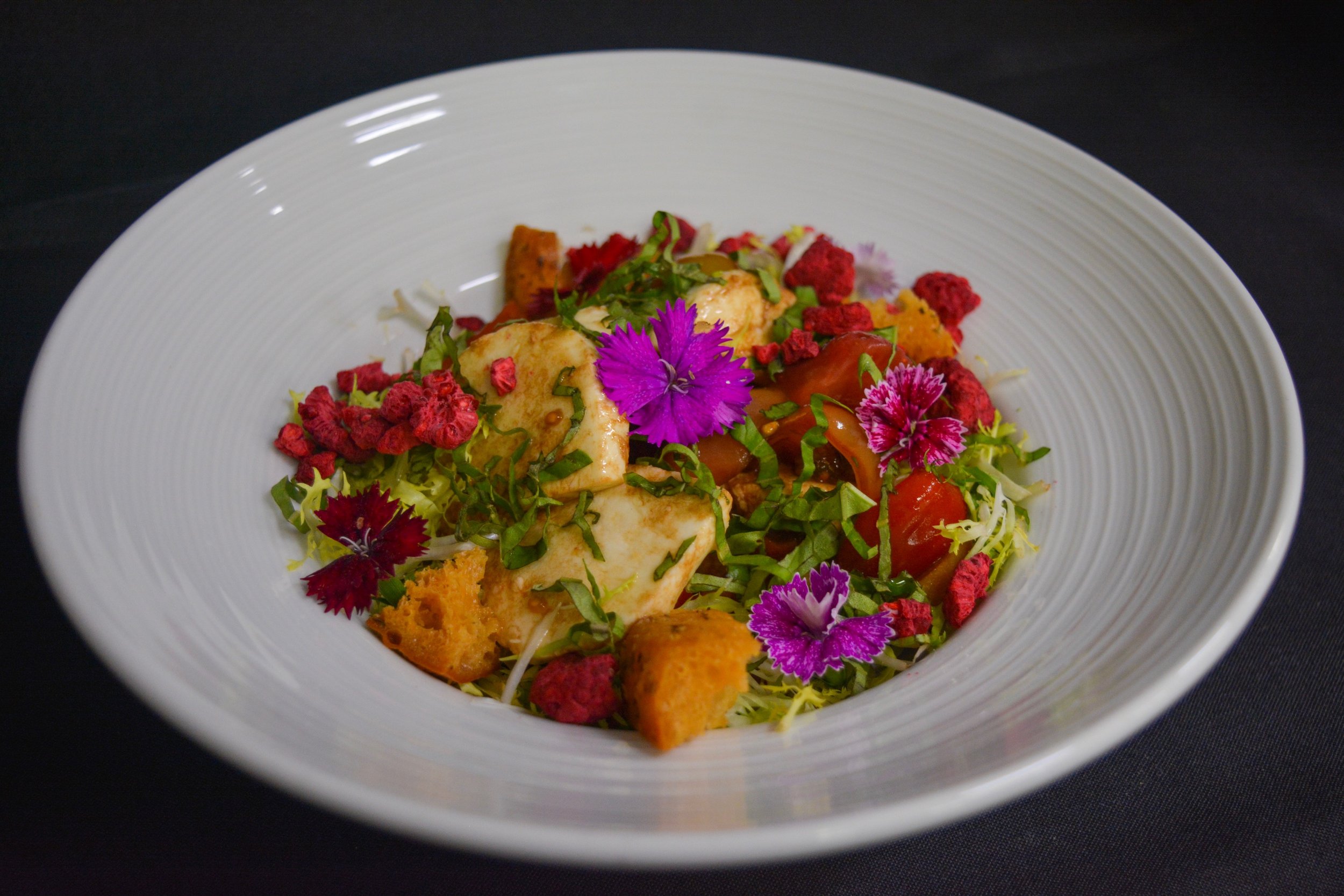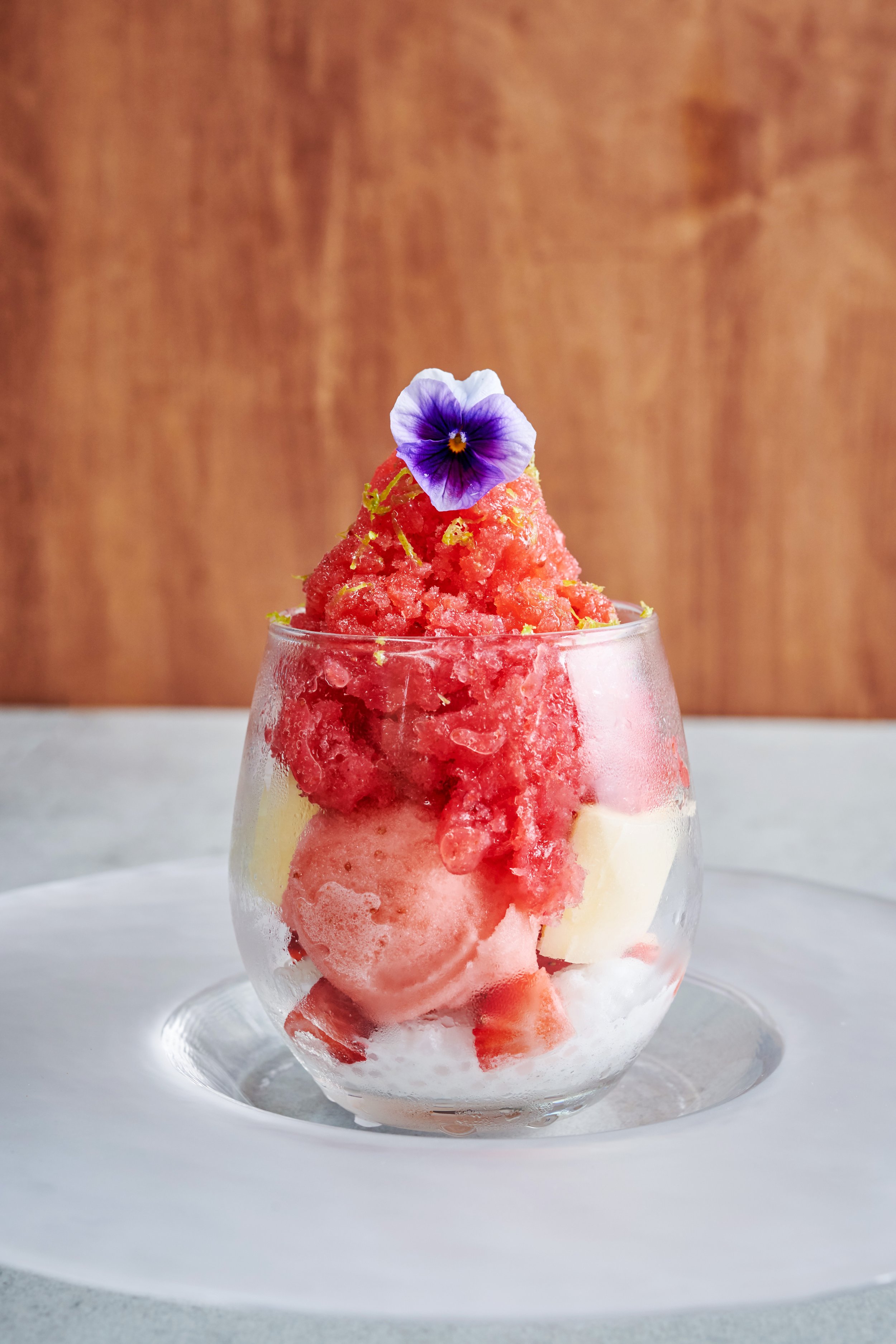Power Plants


After snapping her Instagram shot of MW Restaurant’s “Shave Ice,” my wife extracts the viola nestled atop the mound of frozen shaved strawberries before flicking it onto the cocktail napkin liner — the bloom relishing its fleeting moment of fame before being discarded forever as a garnish with an expired purpose. While that tiny flower was placed to contribute a singular pop of verdant sweetness and texture to the dessert, its predecessors had lengthier contributions to culinary history.
Flowers have been an integral part of medicine and cookery as far back as Ancient Greek and Roman times, with evidence of its use found in Incan, Aztec, Middle Eastern, Indian, and Chinese cultures. Aztecs and Hindus consumed flowers in ritualistic applications, while the Chinese discovered their medicinal value and included them in dishes, such as dried lily buds in Jai dishes as the Buddha’s Delight. During the Victorian era, the widespread fascination with assigning flowers meaning and incorporating them into a furtive vernacular also gave rise to their use in confections, be they crystalized with sugar or pounded into conserves.
In contemporary kitchens around the world, edible flowers continue to thrive. Some play a major role in a dish, such as the abundant broccoli florets used to cradle fish or scallops in several dishes at Xian Yue Hien in Shanghai. Back in Hawai‘i, Vikram Garg serves a steamed artichoke with aged balsamic at his newly opened restaurant TBD.
However, most perform a subservient capacity, implemented as an accent for flavor or now more commonly, as an aesthetic on a dish. Flowers are also used to breathe life to salads, with corn and popcorn shoots, pea shoots, and pansies adding strokes of color and sweet, peppery, citrusy or astringent flavors to otherwise monotonous lettuce. Marigold flowers do just that for Matt Dela Cruz’s caprese salad at Humble Market Kitchin by Roy Yamaguchi in Maui. Saffron, basil, sage, thyme and chives flowers all make for more attractive savory applications, some imparting bolder notes than their leaves. In traditional kaiseki restaurants, such as Imahan, Waketokuyama, and Tofuya Ukai in Tokyo, intensely aromatic shiso buds or chrysanthemum petals commonly accompany the “tsukuri” or sashimi course.
A few chefs have found creative methods to incorporate flowers. Grant Achatz wraps frog legs and nasturtium flowers in the leaves as “tacos” placed atop a tree stump filled with nasturtium milk for pairing at Alinea in Chicago. Others utilize them for artistry, such as Tobias Gensheimer of Pierre Osaka who decoratively plants honeyed, grassy-flavored Egyptian starflowers alongside fresh and pickled vegetables on an ingot of water buffalo mozzarella and fruit tomato gelée, and Hana No Bavarois Havaro Tokyo which suspends flowers in gelatin domes nestled atop Bavarian cream as a fashionable dessert.
The mere aesthetic use of flowers, however, goes against the beliefs of many chefs. While it is tempting to juxtapose a pansy for a splash of contrasting color, chefs such as Chris Kajioka of Senia staunchly believe that the garnish must contribute to the composition, raising the question of whether the continued use of decorative flowers will be nipped in the bud or allowed to blossom. Kajioka is pondering their reduction at Senia. Hubert Keller of Fleur in Las Vegas disclosed that despite using edible flowers in the early ’80s, he has since moved away from them, as the more recent introduction of micro herbs and greens are practical in imparting particular flavors to dishes while still adding the perception of freshness for which flowers were initially used. On the other hand, local farms such as Mari’s Garden have witnessed bolstered demand within the past few years, resulting in expansion to varieties such as nasturtiums, garlic flowers, violas, pansies, borage, marigolds, moonshadow hyacinth and butterfly blue. Alan Wong shares people eat with their eyes, and as more chefs learn what is available to them, more floral inclusions may be expected on menus, hopefully complementary to the food.
So, while the Valentine’s Day bouquet of roses will never double for the ensuing romantic dinner, it seems that decorative flowers will continue to maintain a presence in culinary circles, at least in the near future. Their capacities will certainly evolve, with perhaps its mere ornamental design purposes falling into obscurity as with its predecessor, the wilted parsley sprig. However, their uses may morph more into the role of herbs and accents. Besides, some are thought to have healthful benefits — violas, in particular, possess phytochemicals and other medicinal constituents that were once believed to possess therapeutic applications including the purification of blood, and treatments of ailments from the common cold to cancer. So before simply dispensing with the floral garnish, just remember that it is more than just a pretty face — at the very least, it is likely there for flavor or texture, as it has been for centuries and as it may continue on for perennials to come.
